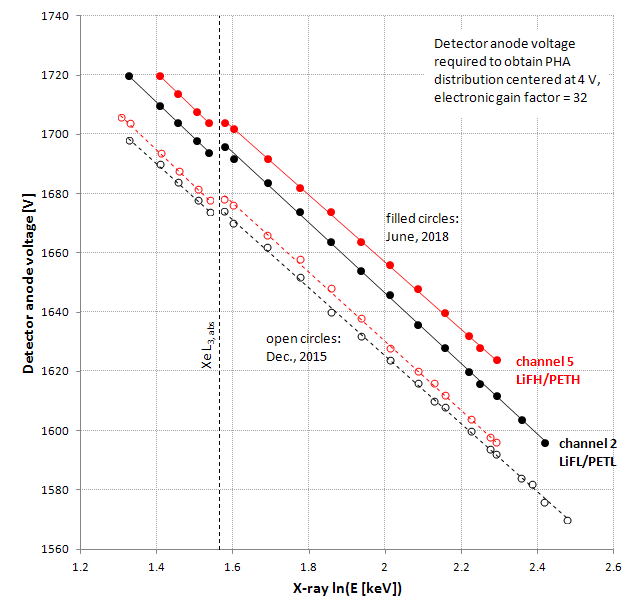Resurrecting an old thread...
I’m in the midst of evaluating the performance of our three Xe-filled detectors. Two of them (on channels 2 and 5) were replaced in December, 2015, while the third (channel 3) has been in service since October, 2011. Channel 5 contains “high intensity” LiF and PET diffracting crystals, channel 2 contains large-area LiF and PET crystals, and channel 3 contains “normal” LiF and PET crystals. Compared to what I observed in December, 2015, all counters require an increase in anode voltage in order to obtain pulse amplitude distributions centered at 4 V. In all cases I collect the distributions after adjusting the count rate at the peak to ~5000 s
-1.

Channel 5, which in normal service produces the highest count rates for a given X-ray line is showing evidence again of formation of a “ghost” peak at amplitudes just above the main peak in the PHA distribution. The distribution for channel 2 is still the typical semi-Gaussian distribution. The counter on channel 3, which gives the lowest count rates of the three channels, is showing formation of a tail on the low-amplitude side of the distribution; the tail is present for a wide range of X-ray energies below Xe L
3,abs. It may also be present at high energy but is obscured by the Xe escape peak. That tail, which is somewhat subtle, is illustrated here for Sn La:

It makes sense that the counter on channel 5, which receives more ionizing radiation than the other two counters, would be expected to show the most rapid deterioration in performance. This may be due, for instance, to contamination of the anode by breakdown products of the C-rich quench gas (CH
4 or CO). Relative to the main peak in the pulse amplitude distribution, the height of the ghost peak observed on channel 5 varies with X-ray energy. For X-ray lines with energies above that of the Xe L
3 absorption edge, the height of the ghost peak decreases with decreasing X-ray energy, though it is still visible, for instance, for V Ka. With further decrease in X-ray energy, for lines of energy just below Xe L
3,abs (e.g., La La and Ti Ka), a prominent ghost peak reappears, but is closer to the main peak than for X-ray lines of higher energy. Once again, as X-ray energy decreases, this ghost peak becomes less prominent and then disappears completely for X-rays of energies less than about 2.5 keV. See the sequence of PHA scans below, which are arranged in order of decreasing X-ray energy.
Ge Ka (9.874 keV, gain = 32, bias = 1624 V):

Ni Ka (7.471 keV, gain = 32, bias = 1656 V):

V Ka (4.949 keV, gain = 64, bias = 1612 V):
 ----------------------------- Xe L3, abs (4.783 keV) -----------------------------
----------------------------- Xe L3, abs (4.783 keV) -----------------------------Ti Ka (4.508 keV, gain = 64, bias = 1618 V):

Te La (3.769 keV, gain = 64, bias = 1640 V):

Ag La (2.984 keV, gain = 64, bias = 1672 V):

Mo La (2.293 keV, gain = 64, bias = 1698 V):
